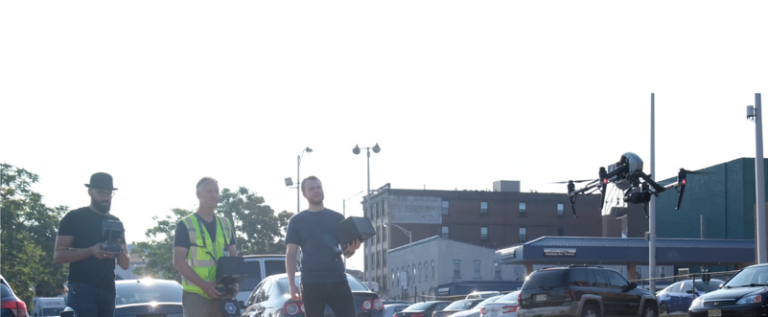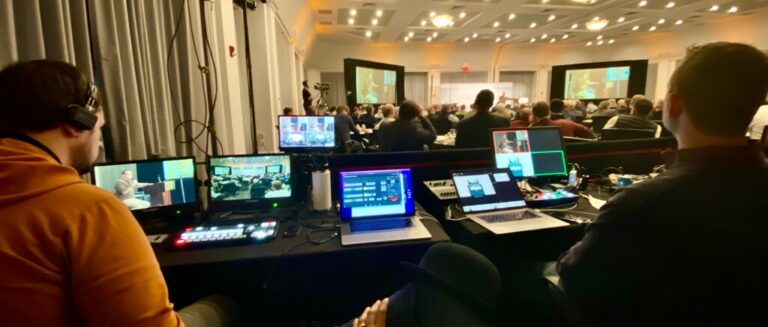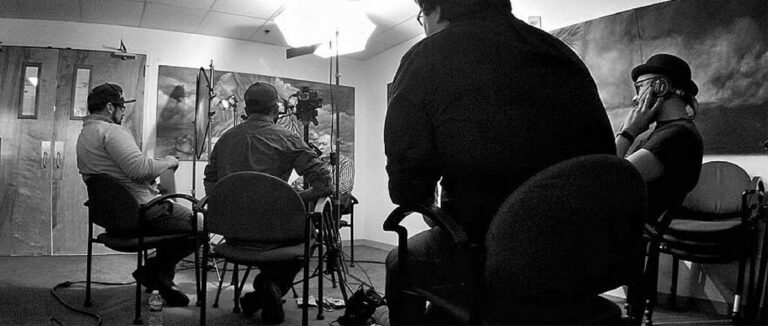It’s safe to assume that if you’re here, you’re already pretty convinced that video production is kind of an important deal.
A lot of marketers agree that by the end of 2023, video content will account for 82% of global internet traffic. This is a bit of an increase from 2020, when research predicted that video content would make up 80% of global internet traffic & this is due mainly to the rapid increase in accessibility & convenience of platforms for these videos to live, such as Facebook, YouTube, & TikTok.
We already discussed the WHY when it comes to the future of this social media movement in our blog GO BEYOND THE BOUNDARIES: PUSH AHEAD WITH 2023 VIDEO TRENDS, where we explain the latest trends essential for video production (if you haven’t read that yet we advise you check it out before you read any further).
Now, we’ll tell you the WHAT when it comes to simple & cheap video equipment, online resources & story formulas that will help you successfully launch your video content to give you the best impact for your organization!
Planning for Success – Utilizing a Story Formula:
The first step to any successful video comes before you even shoot anything; careful planning. The key to this planning is to ensure that you create the most engaging & effective video for your organization, & you can do this by utilizing a proper story formula.
There are seven basic elements used across all stories, which we analyzed, broke down & use on every project our video production company heads into. If you do the same, you’ll set your organization up to have a much more impactful marketing tool in your new story-driven video.
One of the most common mistakes we encounter is that organizations try to use too many voices in their video; squeezing in as much information as possible. This ultimately pushes the length of the video longer & longer until you’re watching a twenty-two minute episode of television & creates a rather boring piece to watch.
The core of your video should be your main character. In the context of using an interview format, the main character, or characters, would be your Hero & the Guide.
Quick explanation, your Hero is going to be the people your organization serves, the people that use your services, funds, or resources to get out of that dark place and improve their life. The Guide would be you! Your organization, non-profit, or socially responsible brand guides the hero along their journey from darkness to light, but the main focus of the story is going to be the hero, because that’s who your audience will relate to!
Through using the story arc & figuring out the seven basic elements of YOUR story (including your Hero and Guide) you will find the exact direction that you need to head to optimize your visual storytelling efforts. Once you’ve completed this first step, you will have set yourself up for creating a successful video that is both entertaining & informative.
Invest in Cheap, Simple, High-Quality Equipment for Better Results:
We know that every organization is different when it comes to what type of budget they have for marketing. Whether you’re a non-profit, business, or socially responsible brand, we’ve compiled a list of equipment which we think would benefit any organization. Here’s our list of preferred video production gear of varying prices & we’ll also give you the secrets on how to get the best use out of each item below.
No Budget:
– Your Phone!
- Shooting video with your phone can be a great way to create content quickly & without having to buy an expensive camera. Most smartphones will have a 4K camera on it with a wide-angle lens, & since most people have a smartphone sitting in their pocket at all times, we’ll call this the most convenient & cheapest option for any organization. Now, anybody can point their phone & click record! But there’s more steps you can take & more equipment you can use to synergize the effectiveness of using your phone’s camera.
Low Budget:
– DJI OSMO Mobile 6 (Stabilizer)
- To get the best results out of your video, it’s important to use steady hands for smooth camera movements; your viewer might get nauseous if they feel like they’re on a ship rocking in the waves while watching your video. Using a simple stabilizer can help you get fluid shots moving around your environment. There are a lot of great stabilizers for cameras, but they even sell some specifically for smartphones, & for this we recommend the DJI OSMO. It unfolds, it fits in your hand, you clip your phone in & just balance it. That’s it! This piece of equipment will run you about $150, but it will last!
–Aputure LED Lights (Lighting)
- Of course, natural lighting is a great option when you want your subject visible on screen, however, that’s not always something you can rely on when you’re filming inside, at night, or when it’s really cloudy. With hundreds of different lights available for purchase, we know it can be overwhelming to pick out what’s best for your video. We’ll help you whittle down your research & tell you that Aputure is our go-to brand. Whether it comes to our professional studio, or standing out on the street interviewing a volunteer at a food distribution event, we have an Aputure light ready to use to light our subjects properly. Different amounts of light are needed for different occasions, but one thing we realized is that even the smallest light can make the biggest difference & that’s why we recommend grabbing some Aputure LED Mini Lights. These small pocket sized LEDs can help create the perfect ambience to bring your subject to life, enhancing your color palette & allowing you to light those tough-to-get angles with their amazing versatility. These small lights run at roughly $90 a light, larger lights vary.
–Rode Wireless Go II (Lav Microphone)
- Even if you have the best visuals with amazing lighting & smooth movements, they will undoubtedly look amateurish & unprofessional if you have poor audio. Rather than using the onboard mic on your camera or phone, you should instead try to use an external microphone whenever possible. Even without any post-production work, you’ll be able to tell the difference right away. Whether you’re conducting an intimate one-on-one interview or trying to record the sounds of the noisiest cars driving down a highway, the proper choice of microphone requires some general knowledge & research on how microphones work. However, if we were to recommend any microphone that will cover the most bases, it would be the Rode Wireless Go II. We find that most nonprofits & organizations trying to make video tend to include voiceover or interview sound bites from their donors, volunteers, etc. With this in mind, these lavalier microphones can be attached directly onto your shirt & with the right placement (about 6 inches down from the mouth) they can get a gorgeous sound that will make your audio feel extremely professional. These mics will run you about $300, but they’re durable & with an adapter for your smartphone, they’ll really improve the quality of your video & we would make this your first priority purchase when it comes to this tier of low price equipment.
Decent Budget:
–Canon EOS M50/Sony ZV-1 (Cameras)
- If your organization has a decent budget or you’re just really committed to getting your video quality greatly improved, the next investment we advise you to make is to grab a professional DSLR camera. The two options we recommend are both simple & easy, point & shoot. Sony’s give you great quality video right out of the camera, but they sometimes require a degree just to operate their menu system. With that in mind we found the Sony ZV-1 to be the best beginner Sony. The same goes with Canon, being an entry-level mirrorless camera with excellent image quality, the Canon EOS M50 is our first choice. So depending on your price range & general preference, we would say that these are two of the best first options to research & consider. And we DO advise you to conduct a bit of your own research beforehand to figure out which would be your better option. We also advise you to get familiar with your equipment after you buy it. There’s great online videos & even classes you can take at various camera shops where you can get familiar with how to operate the camera menus & settings so that you can develop your own technique even further! These cameras will run you about $600-$750.
– Other Camera Options
- If you don’t like our previously mentioned suggestions, there’s a plethora of other camera options available that can give you similar if not better results. We’ll list off a couple alternatives that we think are still high quality but simple to use.
- Canon Powershot G7 X Mark II
- Canon EOS R10
- Sony Alpha ZV-E10
- Sony Alpha 7C
- Sony Alpha 7 IV
- Sony Alpha 7S III
- Sony Alpha FX3
- LUMIX G7HK Mirrorless Camera
- Nikon Z 30
- GoPro HERO8 Black
–Rode VideoMicro/Rode VideoMic Go (Shotgun Microphones)
- We can’t overstate this, your audience can tolerate a bad or out of focus video but our ears just cannot tolerate bad audio. You always want to record your audio in a quiet environment, but using a shotgun microphone will help hone in on the exact sound you want to record when you can’t necessarily get to that silent space. Shotgun microphones are intercardioid, meaning they are designed to capture sound from whatever they are directly pointed at & pick up less ambient noise from the side or back. Going back to our favorite microphone company, Rode developed these microphones that slide right into the shoe mount of your camera. They’re light, they’re durable, & the sound quality is great! These RODE mics will run you about $50-$100.
Investing in high quality & professional film equipment can make a huge difference in the quality of your video, ensuring that your videos can be created quickly & efficiently, helping you save time & money on your production costs. Whenever we need to purchase equipment for our video production company, or even just get an opinion on what piece of gear would work best for our specific needs, we always check out B&H. Their website has a ton of information & choices for you to sift through & utilizing their simple comparison tool can help inform your decisions as you head into your video production process.
Navigating the Shoots: Figuring out what video to capture:
The visual content which you should capture depends on the goals of your video. A video for business storytelling is going to be different from a video for non-profit storytelling, so think about your audience and what you want them to do after watching; again this should all be planned during the pre-production process.
Is it going to be a recruitment video? Interview some new hires about the hiring process, or your volunteers about why they dedicate their time to your organization. A Fundraising video? Talk to the people whom the money is going to & ask them how the money will impact their life. Hearing from the people being directly impacted by the organization is the easiest way for the audience to draw a connection.
Now all this is good & fun, but don’t you want your video to be engaging & exciting to watch as well?
This is where B-roll comes in. B-roll is supplemental footage to go over the narrative; aka the interview. So while your new hire is talking about office culture, you can show footage of the team engaging with each other or brainstorming ideas at the conference table. Over the volunteer interview, you can show footage of them packing boxes or distributing food, some type of action to allow the audience to get some more context on the topic. Keep in mind, your video needs to be Entertaining, Engaging, or Educational, but works the best when it’s all 3!
B-roll isn’t something you can just record last-minute with no real purpose or goal in mind. It takes a lot of planning to figure out what footage will help tell your story in the most effective way. If you’re unsure what to shoot for B-roll, check out videos from similar organizations on our work page.
Remember… B-roll for a recruitment video will be different then B-roll for a fundraising video.
If you know who your audience will be from the start, that will inform all the creative decisions throughout the rest of the process, including HOW to interview your talent.
When interviewing your talent, think about what questions would best be utilized in telling a story. Raw facts & statistics turn your audience cold, so instead focus on personal history & feelings such as “what would be at risk without your brand” or “how did this non-profit organization help change your life”.
We have a typical list of questions we ask at almost every interview, but we use what’s known as a pre-interview to help create more specific questions that will make the story feel even more personal. It’s essentially an intro interview where we get to know the talent a bit better, and test the waters with some questions about their interactions with the organization. We also use this opportunity to make sure that said person would make a quality interviewee; they’re comfortable answering questions on camera in a way that your audience would be able to easily understand.
While some of our pre-interview questions carry over to the real interview, we never give the full list of interview questions to our talent beforehand. We like our stories to come off authentic, and that means having questions that talent innately knows & can answer very naturally.
Any hint that the video is scripted & your audience will disconnect immediately. When they listen to the interview and see the hero opening up, being vulnerable & raw, THAT’S what hooks your audience & moves them to donate, buy, or volunteer!
With that being said, your CTA or “Call To Action” is another key part of the process which you should have planned out before you even begin shooting. A CTA is an instruction or prompt at the end of the video that grabs your audience’s attention & motivates them to take action.
And while there are many options for what your CTA can be, just give them one thing to do!
Don’t list out every single action your audience can take. If it’s a volunteer video, simply say “You can volunteer today!” Remember, this is the beginning of a conversation or part of an ongoing conversation, there’s more chances for your audience to learn more & be directed towards more actions through your website or other videos.
Uncover the Benefits of Online Media Resources & Video Services:
Once you get all of your equipment & shoot your footage, the next step would be editing the footage to create your video.
But wait! Here’s the secret… YOU SHOULD NOT BE EDITING AT ALL!
We know you’re busy running your organization, so you shouldn’t waste any time putting together the video when you should be helping your people!
There’s a plethora of online resources available to find people who will edit for you. Take fiverr for example; there’s a long list of experienced editors who you can give recurring work to, for a fair price. The price of each editor varies by experience, but you would be surprised what can get done over the course of a couple months with a budget of only a few hundred dollars.
Certain editors are experts on certain platforms, so definitely figure out which platforms you will utilize before you hire your editor. We found that YouTube shorts have been increasing our community engagement the most, but something like Facebook or TikTok could work better for you, it all depends on your organization!
However, if your budget only allows you to edit the video yourself, we recommend that you use the free editing software Davinci Resolve. It’s extremely user friendly & has some useful high-quality editing capabilities that even professional editors use! Its color correction software is top notch, so if you really want to dedicate some time editing then that’s a great additional tool.
Otherwise, there’s a lot of other free editing programs available to download for free, with some even coming pre-downloaded, such as your iMovie (Mac) or Clipchamp (Windows). Spend a bit of time practicing with your options & see what you’re most comfortable with.
Invest in Video Production – The Benefits Outweigh the Costs
As you’re probably aware by now, there’s a lot that goes into the process of creating your own video, but it doesn’t have to break your budget! There’s quick & cheap solutions to almost every problem you come across in this field, as well as easily accessible gear that will take a lot of stress off of your marketing & video team.
There’s a whole lot more to talk about, but if you want to learn more, check out this video below where our very own Jason Ellinger & Matt Carpenter participate in a non-profit education conference, The Big Innovation presented by Community Boost, where they dive much deeper into these topics in their presentation “You need video! This is how.”
While learning how to film your own video is a very useful skill to have, nothing beats using a professional video production team. So reach out, let’s have a conversation!
And even if you just wanted to ask for some tips & tricks to enhance your visual storytelling skills, please feel free to contact us or check out our other blogs & content.
Blog by Jason Ellinger (with a little flavor from Kwami Ngaojia)
Subscribe & Check-Out our YouTube channel: https://www.youtube.com/@beardandbowlerproductions






